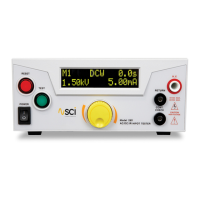hipot.com 49
Appendix D - Remote BUS Interface: USB
This section provides information on the proper use and conguration of bus remote interface. The USB remote interface is
optional on all 290 Series models. Please see the OPTIONS section of the manual for details.
USB Interface
This interface provides all of the control commands and parameter setting commands. All commands can be found in the
command list of this manual. The USB interface card requires you to download a driver in order for the instrument to recognize
the USB interface. The driver can be found on the Slaughter Company, Inc. website:
www.hipot.com/products/290.aspx
Click on “USB Driver” to download the driver. This link contains an automatic extract and install program. Follow the instructions
of the installation program to initialize the driver install. NOTE: The USB port acts as a USB to RS-232 converter. As a result, the PC
will recognize the USB port as a virtual COM port.
The COM port should have the following conguration. 9600 baud, 8 data bits, 1 stop bit, no parity. This interface does not
support XON/XOFF protocol or any hardware handshaking.
When sending command over the USB bus, the tester will send a response string of 06 hex or 6 decimal, the Acknowledge (ACK)
ASCII control code if the transfer was recognized and completed by the tester. If there is an error with the command string that is
sent, the tester will respond with 15 hex or 21 decimal, the Not Acknowledge (NAK) ASCII control code. The ACK or NAK response
allows for software handshaking, to monitor and control data ow. When requesting data from the tester, it will automatically
send the data back to the controller input buer. The controller input buer will accumulate data being sent from the tester
including the ACK and NAK response strings, until it has been read by the controller.
USB Interface Command List
The USB bus will automatically send any response back to the controller’s input buer. Note that the commands are case
sensitive and must be typed in capital letters. Each command string should be terminated by the ASCII control code, New Line
<NL>, or OAh.
The following conventions are used to describe the commands syntax for the 290 Series testers. Braces ({ }) enclose each
parameter for a command string. Triangle brackets (< >) indicate that you must substitute a value for the enclosed parameter.
The Pipe ( | ) is used to separate dierent parameter options for a command. The command and the parameter data must be
separated with a space. All commands that end with a question mark (?) are query commands and require an IEEE-488 read
command to retrieve the data from the device’s output buer.
Test Execution Commands
The following commands are used to control actual output voltage and current from the tester. Please observe all safety precautions.
TEST - Starts the test sequence at the selected step loaded into memory (RAM).
RESET - Stop or abort a test. Also used to reset a latched failure condition.
SACO - Set the oset for the Continuity test. The cables and any test xture should be connected before executing the
command. This command will perform an actual test and all safety precautions should be observed when using this command.
Command Description
TEST Execute a Test
RESET Abort a Test in Process or Reset Failures
SACO Set Continuity Auto Oset

